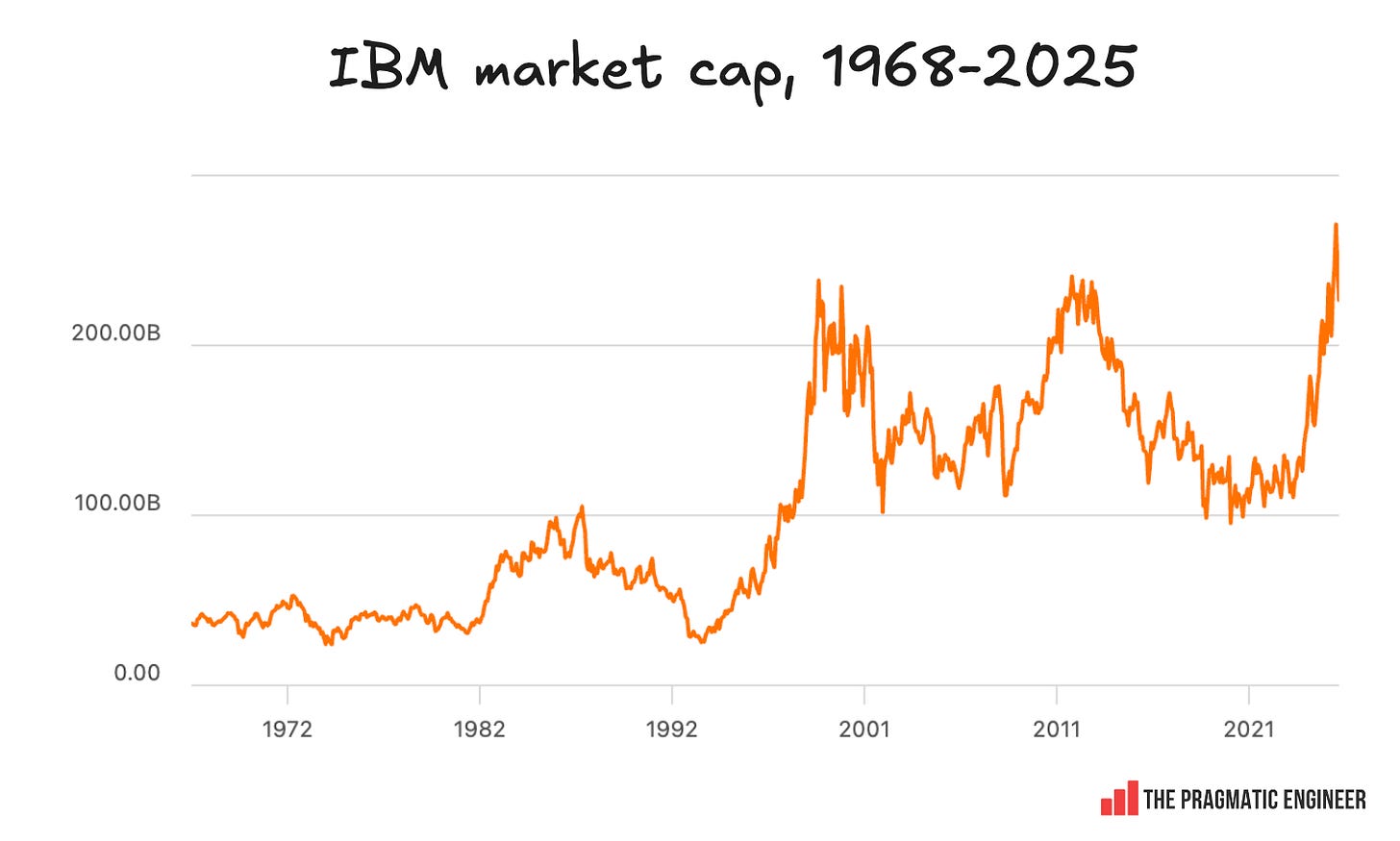State of the software engineering job market in 2025, part 1, what the data says
A deepdive into today’s tech jobs market, with exclusive data on tech jobs, AI engineering, Big Tech recruitment, the growing importance of location, and more
The job market feels pretty weird right now; software engineers applying for roles are finding it harder to get responses – while hiring managers tell me it now takes longer to fill positions even though overall recruitment is, confusingly, slightly up.
So, what’s going on with tech vacancies? To learn more, I’ve spent the past month gathering new, never-before-shared data on tech jobs, and talking with nearly 100 leaders and experienced engineers who are actively hiring or job hunting today.
I want to begin with a big thank you to the partner teams that contributed exclusive data points to this article:
TrueUp: a platform that scans every open job at Big Tech, top startups, and scaleups which typically pay in the top two tiers of the trimodal software engineering compensation model. You can browse all open engineering roles here, and sign up for alerts when new jobs are posted. Thanks to Amit Taylor for data points.
Workforce.ai, a platform built by Live Data Technologies. Live Data monitors 1M+ job changes and 300M+ employment validations each month across companies, roles, levels, functions, industries, and locations. Special thanks to Alex Hamilton for his help.
SignalFire: a VC company that uses a custom-built data source called Beacon AI, which is a data engine that processes and structures information on 80M+ organizations and 650M+ employees from dozens of sources. They usually don’t share their data externally, but made an exception for this article. Thanks to Jarod Reyes for his help.
Today, we cover:
Tech job stats. A slow, steady rise in recruitment across Big Tech and top startups.
AI Engineering trends. Massive increase in demand for AI engineers, with San Francisco’s Bay Area the center of gravity for jobs.
Big Tech hiring stats. Following layoffs in 2022-23, engineering headcount is rising in Big Tech.
Growing importance of location. Many roles are listed in geographical tech hubs, and engineers are more likely to swap jobs if they live in one.
Tenure rising fast at Big Tech. Since 2023, average tenure at Big Tech companies increased at a pace like never before. Is this because people are less likely to quit, or because of Big Tech slowing down hiring?
Where are Big Tech engineers moving to and from? Big Tech is becoming a pretty closed-loop talent market; most Big Tech hires are from similar-sized places.
Engineering leadership recruitment. Amazon is heavily cutting engineering managers, while most of Big Tech except Apple is reducing Director+ roles.
Remote jobs. The volume of remote roles keeps declining compared to a year ago – except in AI Engineering, where more listings seem to be offering remote work than in recent months.
Follow-up parts to this mini-series:
Part 2: what hiring managers see
Flood of applications
Few hires via inbound
‘Top’ candidates are hard to find
Remote jobs: more competition for less comp?
Fake applicants + AI: a growing problem
Higher demand for founding engineers and product engineers
Early-stage startups have their own hiring problems
Job platform data
Junior engineer recruitment rebounds?
Picky employers
Software engineer archetypes in and out of demand
State of engineering leadership hiring
Remote market
Regional observations
Related job market deepdives:
State of the startup and scaleup hiring markets in 2025 – as seen by recruiters
End of 0% interest rates: what the “new normal” means for software engineers (2024)
In Part 1 of this mini-series we’re going to look into data points from the market. A follow-up article will analyze what hiring managers, recruiters, and engineers in the job market are seeing and saying – with extra details.
Now, let’s jump in.
1. Tech jobs stats
Slow, steady rise in vacancies
The good news: the number of software engineering jobs posted by leading tech companies and startups seems to be slowly but surely increasing. Data from TrueUp:

Companies hiring most
Places with the highest number of open positions are mostly Big Tech companies, along with some other publicly traded businesses:
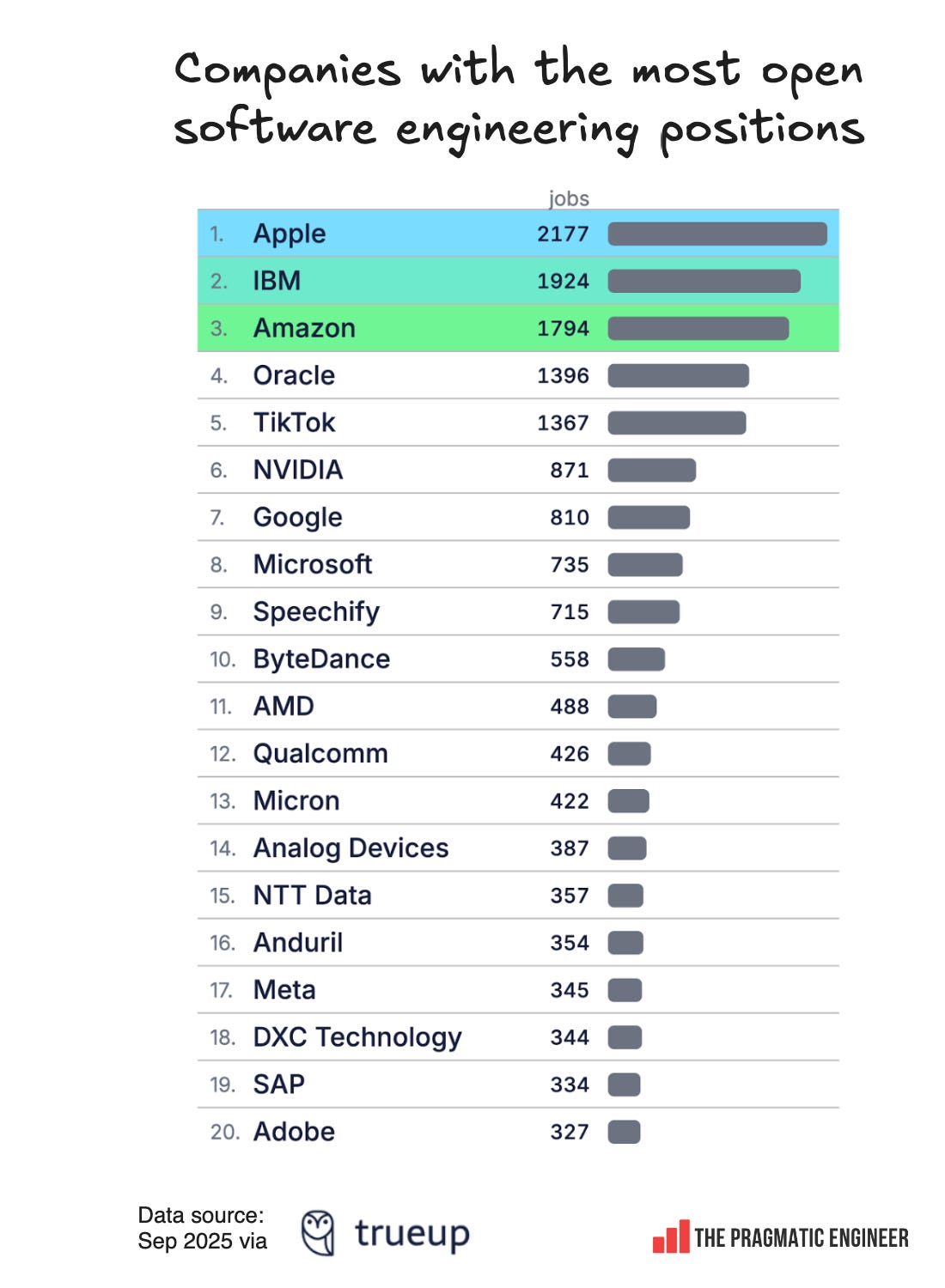
It’s unsurprising that Apple, Amazon, Oracle, TikTok, NVIDIA, Google, and Microsoft are hiring a lot, but a few names on this list catch the eye:
IBM: one of the oldest tech companies, IBM is alive and kicking, and hiring heavily. They are recruiting a large number of backend and generic software engineers, and specialists like AWS DevOps engineers, and SAP/ServiceNow developers. Fun fact: IBM hit an all-time valuation high of $295B this year, and is currently at $225B. This surge suggests business is better than ever.
Speechify: a low profile text-to-speech startup that raised $10M and which lists 800+ engineering jobs in countries such as the Czech Republic, Romania, Egypt, and Canada. These are the same roles in different countries. This company is hiring heavily for somewhere with relatively little capital raised, which could imply the actual recruitment rate may be lower.
Anduril: hiring around as much as Meta, which is notable. This defense tech startup has landed US government contracts and raised $2.5B.
Consulting companies: Also hiring aggressively are consultancies like NTT Data and DXC Technology which offer services and seem to be growing strongly, possibly due to their AI consulting businesses taking off.
Senior-heavy recruitment
Somewhat unexpectedly, there are almost as many open senior positions as there are mid-level and entry-level ones. Usually, far fewer senior roles are advertised.
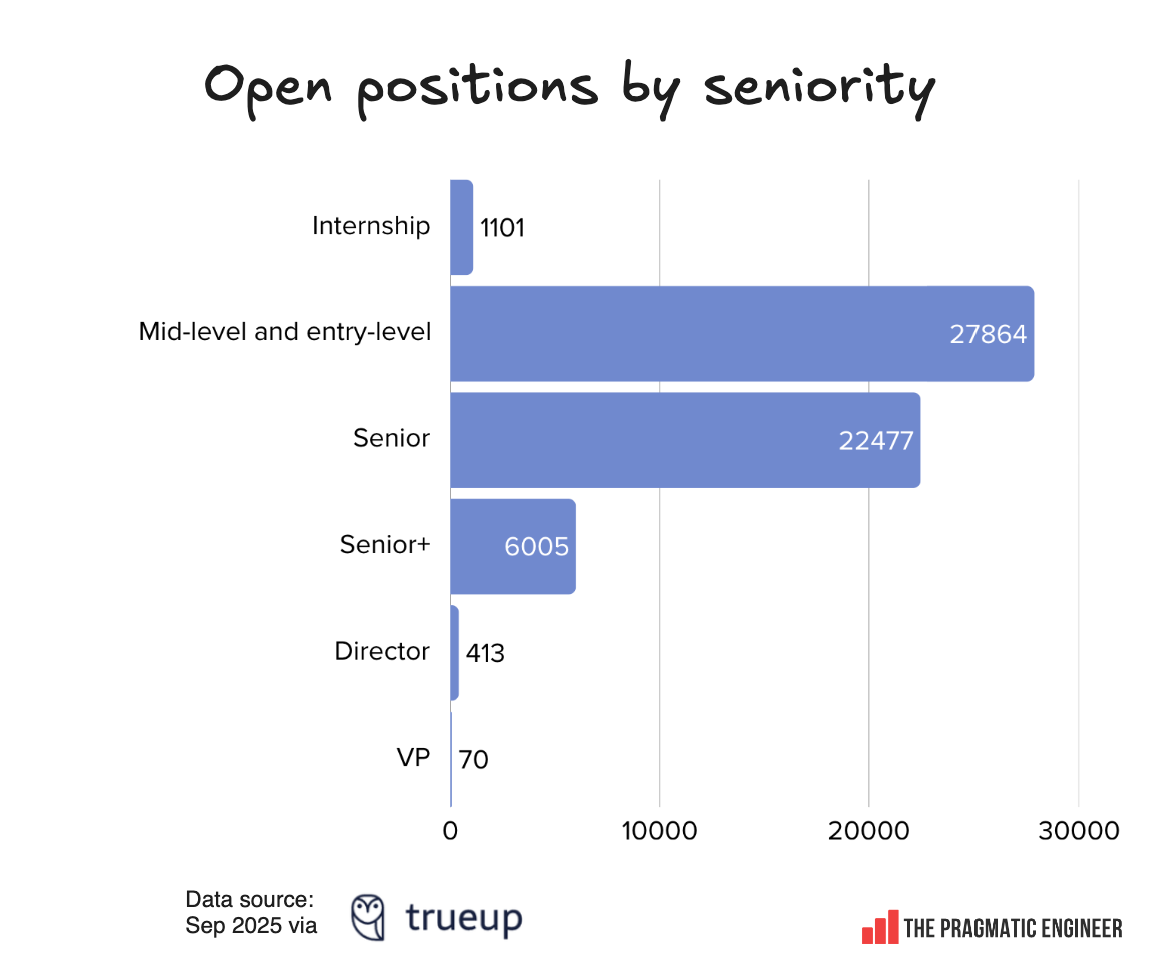
It’s also notable how much of a fall there is in vacancies above the senior engineer level. Perhaps this could lead to senior+ engineers applying for slightly more junior roles in the hope of getting uplevelled during the interview process.
Public tech companies have most vacancies
It’s not even a contest; most jobs listed on TrueUp are at publicly traded tech companies. Trueup scans leading tech companies: Big Tech, publicly traded businesses, and high-profile scaleups and startups. These are places that can pay at the top two tiers of the trimodal compensation model.

2. AI Engineering trends
As we’ve covered before, AI Engineering is the hottest segment in tech, and the number of related listings keeps going up:

It’s easy enough for software engineers to become AI engineers: just build applications on top of LLMs! Recently, we shared seven cases of software developers who have become AI engineers by teaching themselves the skills, and this publication advises readers to consider doing the same. From my notes in AI Engineering in the real world:
“AI engineering is easy enough for software engineers to pick up – and you should. At first, [these people were] hesitant to get involved with building applications on top of LLMs. They knew they did not have the skills, and this new area was not their expertise.
But it turns out that while “experts” like AI agencies know about more tools, they don’t know more about software engineering than experienced engineers do! The AI agency came up with a horribly overcomplicated architecture, possibly just to use as many cool technologies as they could find.
AI engineering is “just” working with LLMs, and using software engineering concepts. When getting started, LLMs are often behind APIs, and any software engineer can invoke APIs and integrate them into their application. If this API uses LLMs behind the scenes; congratulations, you’re doing “AI engineering”.
San Francisco still “HQ” of AI Engineering
Most AI engineering jobs are listed for the Bay Area, in the US, and it’s not even close:
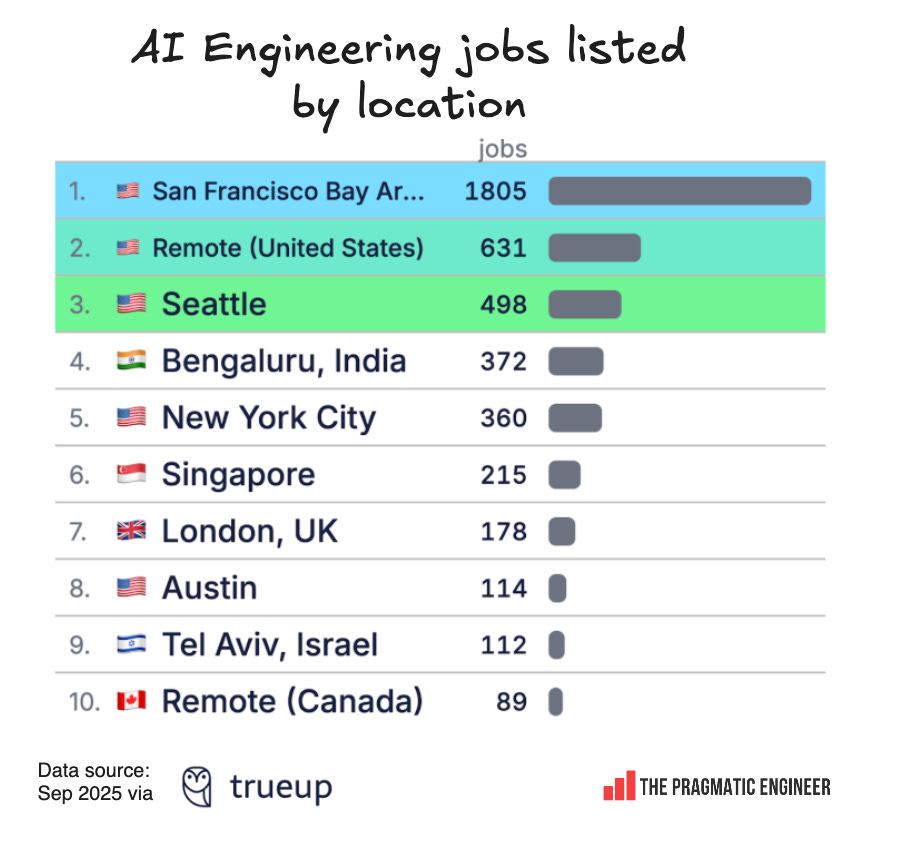
The Bay Area dominates AI Engineering listings. Around 1 in 3 related jobs on TrueUp are based there:
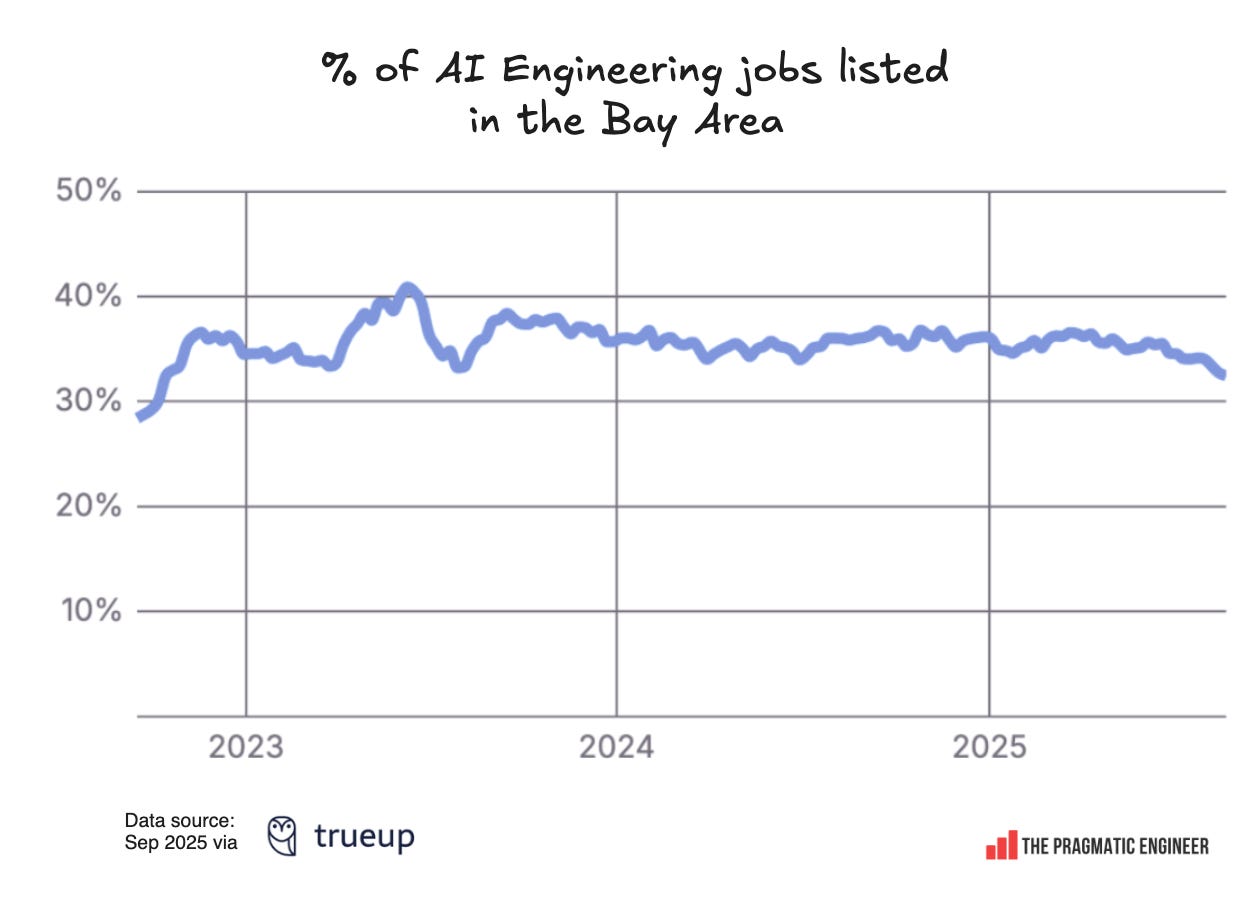
Companies hiring the most AI Engineers
If you’re looking for AI Engineering positions, these are the places that pay well and are hiring heavily:
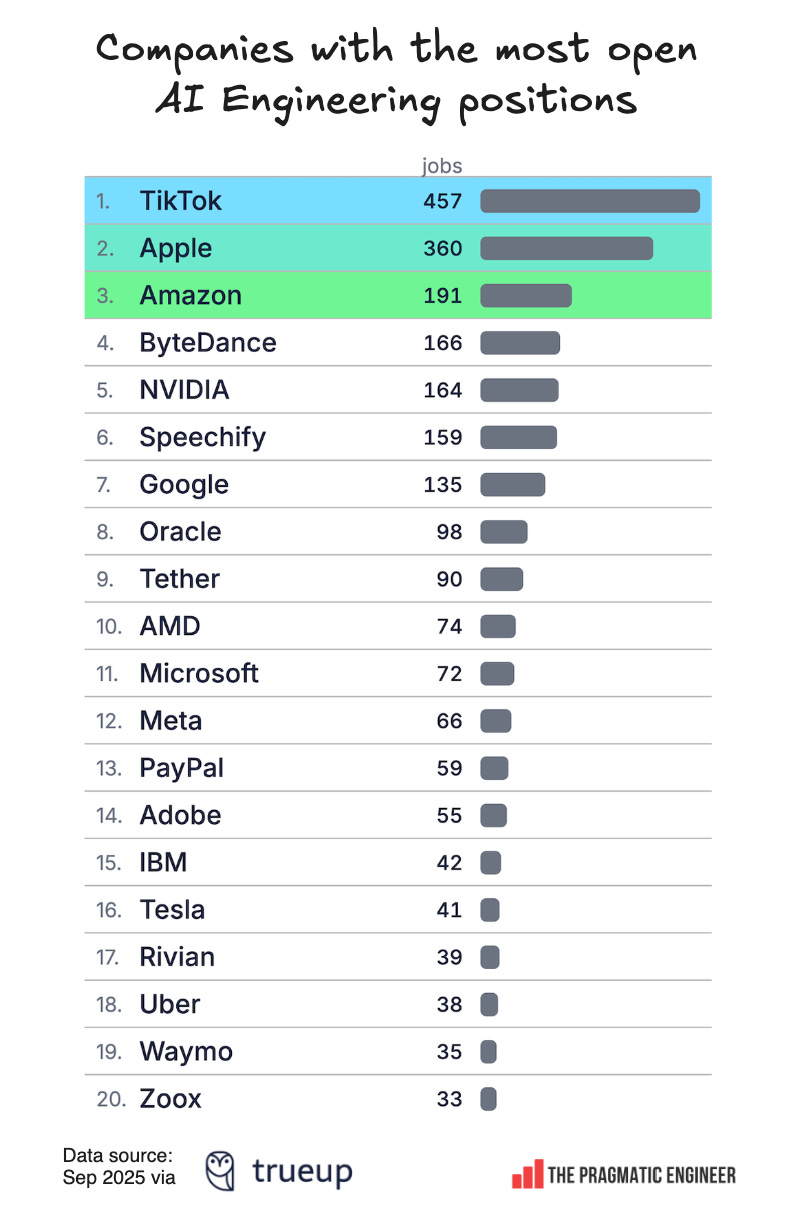
Most common technologies for AI Engineering roles
Most open AI Engineering positions want applicants to be familiar with the AI Engineering stack, and to be hands-on with building LLM applications. An interesting metric here is the most-mentioned technologies in job adverts:
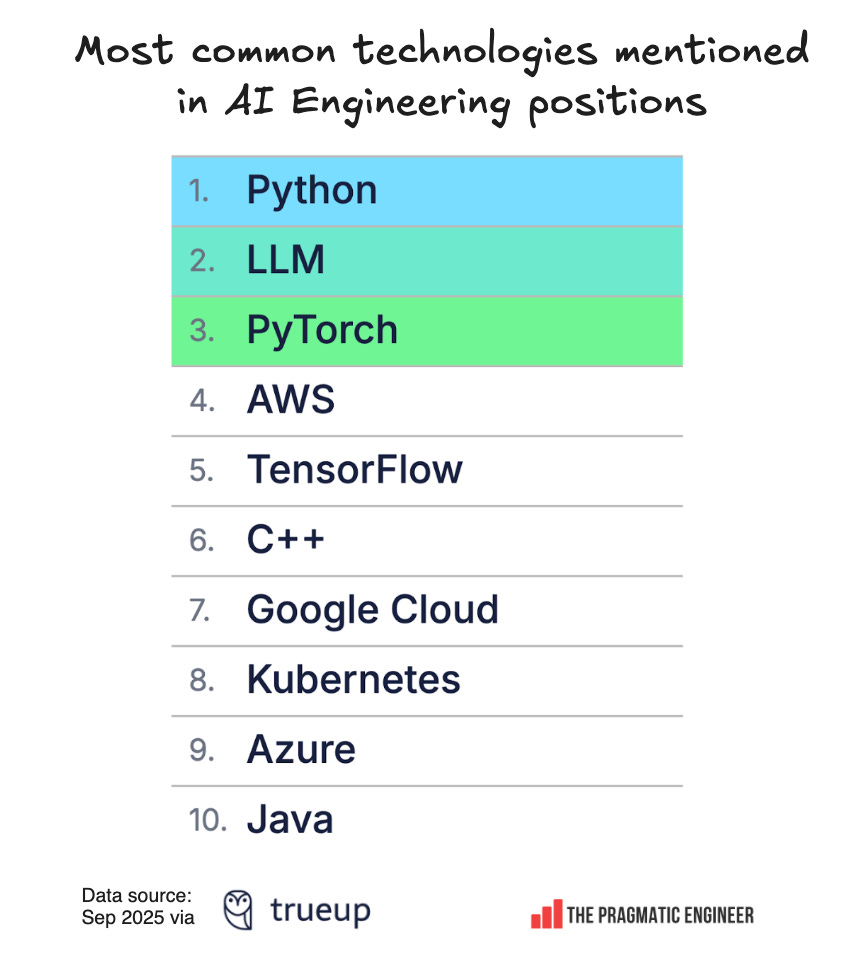
For more tips on how to get hired as an AI Engineer, check out the Pragmatic Engineer Podcast episode I did with Janvi Kalra, an AI Engineer at OpenAI. She had interviews with 46 AI companies, and shares how she moved from software engineer to AI Engineer at Coda, how she prepared for interviews, and researched workplaces.
No single type of AI Engineering listing
From analyzing 200 AI engineering jobs across TrueUp, here’s what I found:
Platform engineering/product engineering divide. Platform-focused AI engineers build centralized tools and infrastructure to accelerate AI development. These roles often have “AI Platform” in the job description. Meanwhile, product-focused AI engineers work inside product teams and ship AI features for users to utilize. This is pretty much the same platform/product split as in the rest of software engineering.
Layers of specialization. Many AI engineering jobs are relatively generic, but there are specialized ones like speech roles requiring experience in automatic speech recognition (ASR), text-to-speech (TTS) ML technologies, and reinforcement learning (RL) focuses.
Foundational model building vs model application. AI engineers who build foundational models are closer to the research side – and these roles are rare. Most jobs expect software engineers to integrate existing models without worrying about how they’re built.
Working with internal vs external customers. Forward-deployed AI engineers work with external customers, while most roles at TikTok, Google and Amazon are internal-facing. We published a deepdive into forward deployed engineers.
Where are AI companies hiring from?
The best way to get into top AI companies like OpenAI and Anthropic is to work in Big Tech or at a high-profile AI company:

This data is pretty sobering; it’s a reminder that it’s easier to get into leading companies if you already work at one. To be fair, this makes sense, as when a company can hire away from Big Tech it usually means they pay the same or better than Big Tech does, and will likely prioritize hiring from such places.
Pedigree remains important, and hiring statistics like the chart above speak to the fact that working for a high-profile employer makes it easier to switch to similar companies.
3. Big Tech hiring stats
Big Tech hires engineers again
Let’s start with the good news: Big Tech recruitment has been on the rise in the last 12 months:
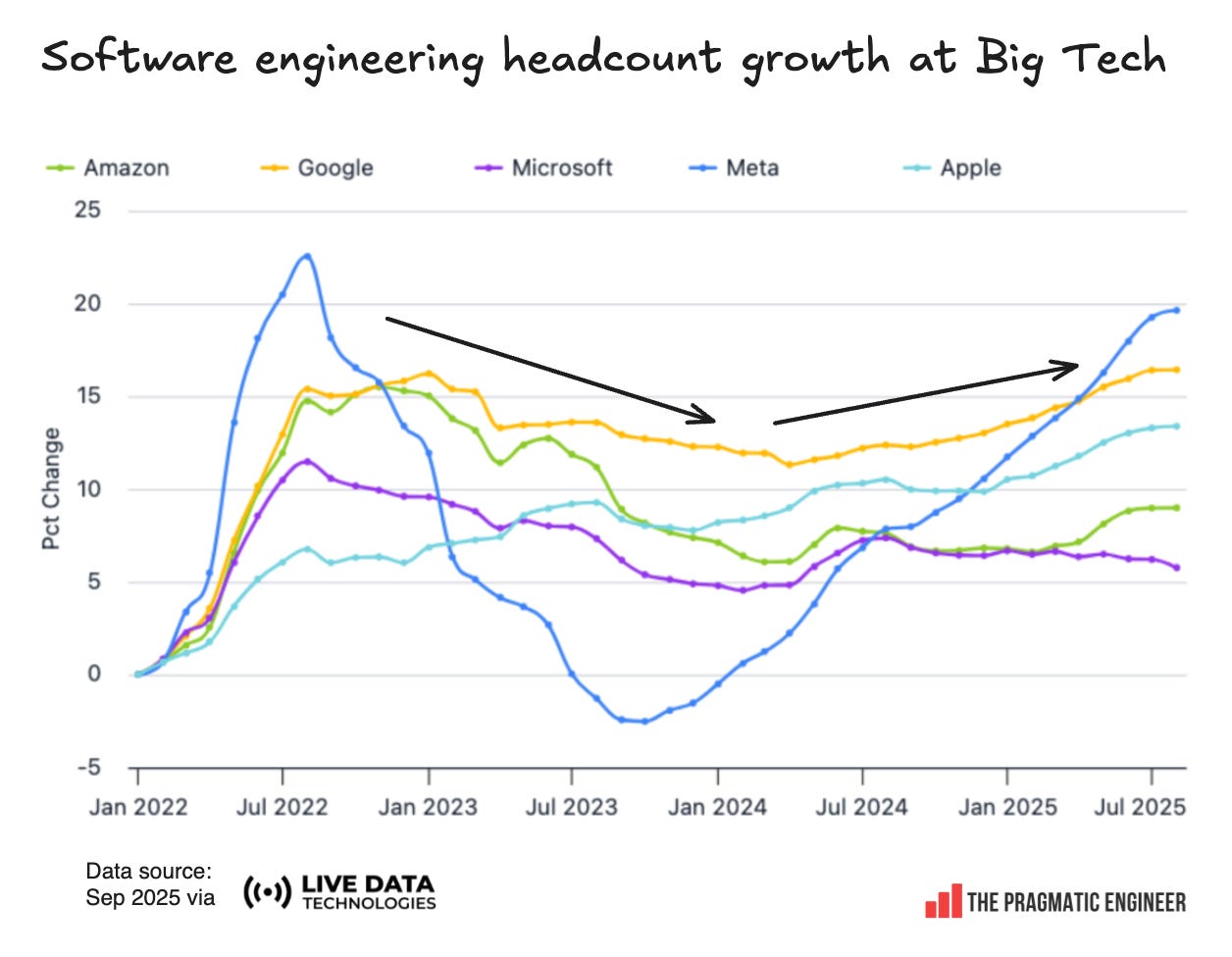
Notable Big Tech trends:
Meta: hiring bounces back. After the sharpest cuts in 2023 (down ~-12%), Meta is now hiring the most engineers. The social media giant has 19% more engineers compared to Jan 2022, which is the biggest recovery among Big Tech employers.
Google and Apple: steady growth. Compared to 2022, Google’s engineering headcount increased by 16%, and Apple’s by 13%. The iPhone maker continues to be the only Big Tech player not to do mass layoffs. Hiring at Google has picked up after its 2023 layoffs.
Amazon and Microsoft: slowest growth. Amazon’s engineering headcount is only 8% above its 2022 level. Meanwhile, Microsoft has barely grown since early 2023.
Fast-growing companies
Several tech companies have been expanding their software engineering teams the past three years, much faster than others:


